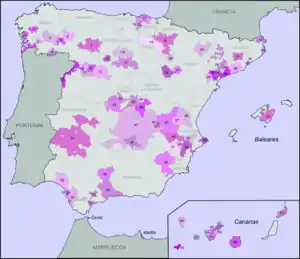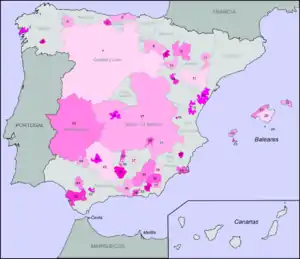Spanish wine regions
The mainstream quality wine regions in Spain are referred to as denominaciones de origen protegidas (DOP) (similar to the French Appellations) and the wine they produce is regulated for quality according to specific laws, and in compliance with European Commission Regulation (CE) 753/2002.[1] In 2016, the use of the term Denominación de Origen (DO) was updated to Denominación de Origen Protegida (DOP) by the Spanish Ministry of Agriculture, Fisheries and Food (MAPA – Ministerio de Agricultura, Pesca y Alimentación); the traditional term of DO can still be used legally on labels, but it will eventually be replaced by DOP.[2]


The wine region classification in Spain takes a quite complex hierarchical form in which the denominación de origen protegida is a mainstream grading, equivalent to the French AOC and the Italian DOC. As of 2019, Spain has 138 identifiable wine regions under some form of geographical classification (2 DOCa/DOQ, 68 DO, 7 VC, 19 VP, and 42 VT).[2] The Spanish DO is actually a subset of the EU-sponsored QWPSR (Quality Wine Produced in Specific Regions) regulatory code (vino de calidad producido en región determinada (VCPRD) in Spanish) which Spain formally adopted in 1986, upon accession to the (then) EEC.[3] The Spanish appellation hierarchy was most recently updated in 2016, and is as follows:[2]
DOP – denominación de origen protegida ('protected denomination of origin'), is the mainstay of Spain's wine quality control system. Each region is governed by a consejo regulador, which decides on the boundaries of the region, permitted varietals, maximum yields, limits of alcoholic strength and other quality standards or production limitations pertaining to the zone. As of 2019 there are 96 DOPs that are subdivided into DOCa, DO, VP, and VC. The sub-categories can be called DOP, or they can use the traditional terms of DOCa, DO, VP, and VC.
DOCa – denominación de origen calificada ('denomination of qualified origin'), is the highest category in Spanish wine regulations, reserved for regions with above-average grape prices and particularly stringent quality controls. Rioja was the first Spanish region to be awarded DOCa status in 1991, followed by Priorat in 2003. Priorat uses the Catalan language DOQ, for denominació d'origen qualificada. These are the only two regions considered "above" DO status.
DO – denominación de origin, the mainstay of Spain's wine quality control system. Each region is governed by a consejo regulador, which decides on the boundaries of the region, permitted varietals, maximum yields, limits of alcoholic strength and other quality standards or production limitations pertaining to the zone.
VP – vino de pago ('estate wine'), a special term for high-quality, single-estate wines (pago is a Spanish term for a vineyard estate) which in some cases also have DO or VC or IGP appellations. This category was formed in 2003.
VC – vino de Calidad con indicación geográfica ('quality wine with geographic indication'), a category formed in 2003 along with VP. The VC category is used for wines that do not fully meet the stringent standards of the DO category, but are above the standards of the IGP category.
IGP – indicación geográfica protegida ('protected geographic indication'). This is below the DOP level, and is wine originating from a specific place, a region or a country, which has a certain quality, reputation or other characteristic - including production phases - that can be essentially attributed to its geographical origin, at least one of which takes place in the defined geographical area. These can use the traditional term Vino de la Tierra (VT).
VdM – vino de mesa ('table wine'), the catch-all at the bottom of the pyramid, for all wine from unclassified vineyards, and wine that has been declassified by blending. This includes both inexpensive jug wines and some expensive wines that are not yet classified due to innovation outside traditional lines.
In 2006 a new Vino de la Tierra "super-region" was created called Viñedos de España. This was never ratified by the EU, and it was abolished in 2011.[4]
Although almost all wine regions are confined to specific centres of production, some of the top denominaciones (Cava and Rioja in particular) are the product of more than one Autonomous Community. This is in contrast to Vinos de Pago, where the location criteria are very strict indeed, often centering on specific plots of land and admitting only those wines produced in their immediate vicinity.[5]
List of Spanish Denominaciones de Origen Protegido and Vinos de la Tierra by Community
References
- BOE No.165 dated 11 de julio de 2003 (ed.): «Ley 24/2003 de la Viña y del Vino.
- Driscoll, Killian. "Classification order of Spanish Wine appellations – What do DOP, DOCa, DOQ, VP, VC, IGP Mean?". artobatours.com. Retrieved 20 December 2019.
- "[Denominaciones de Origen e Indicaciones Geográficas] – Alimentación – M.A.P.A". Archived from the original on 20 March 2007. Retrieved 2 June 2017.
- http://www.boe.es/diario_boe/txt.php?id=BOE-A-2011-3147
- [Denominaciones de Origen e Indicaciones Geográficas] - Food - M.A.P.A